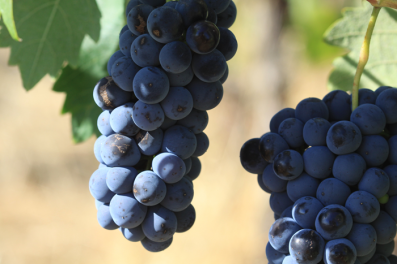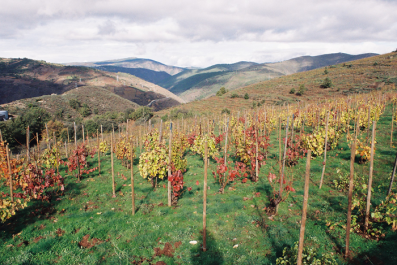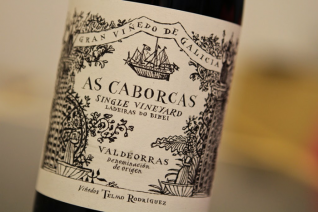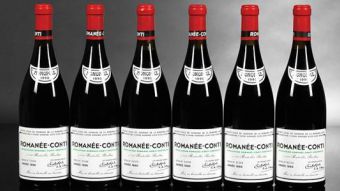Galicia, red wines which don’t go with the flow
Due to a distinctive Atlantic influence and a rich catalogue of native grape varieties, red wines from Galicia have a seductive, fresh, light character, but they are no less complex than the wines which define the archetype of Spanish red.
 Algueira CarballocovoEven if we accept that Spain is a country of red wines, those that we know and love so well, we can still challenge the stereotypical depiction of Spanish red wines as being powerful, concentrated potions, pronounced in colour and generous in alcohol.
Algueira CarballocovoEven if we accept that Spain is a country of red wines, those that we know and love so well, we can still challenge the stereotypical depiction of Spanish red wines as being powerful, concentrated potions, pronounced in colour and generous in alcohol.
The advent of modern winemaking naturally brought with it an improvement in quality, as well as a noticeable standardization in expression (or style, if the reader prefers) of the wines from the different regions of Spain, but with it there also came the conviction that real red wine had to stain the glass and the teeth, and submit the taste buds to a massive onslaught of tannin.
This model of red, validated by the scores conferred by guru Parker’s ambassadors, among other things, has remained the reference until very recently (just two or three years ago). Since then, fans of local reds have been breaking the enchantment and rediscovering Spanish red wine, which is much more varied than they had lead us to believe.
Reasons for the difference
 This change of image has been brought about by Galicians reds, which have gone against the tide that has prevailed over recent decades.
This change of image has been brought about by Galicians reds, which have gone against the tide that has prevailed over recent decades.
These reds differ from those produced in the rest of Spain for several reasons. The prime reason is the local climate: heavy rain, little sun (which makes it hard for the grapes to ripen), excessive moisture (with the consequent risk of vine diseases), etc. Geography is another factor which does not facilitate the cultivation of vitis vinifera. The vineyards’ location in the mountains, by the coast, creates different microclimates and tremendously fragmented parcels, broken down into sinuous vineyards, some almost inaccessible. On this land, the diversity of soils also promotes the development of the rich nuances displayed by the Galician reds.
The third factor which makes Galician red wines distinct from others in Spain is the wealth of varietals. In this region’s complex vineyards, there is no shortage of red grape varieties to choose from: Mencia, Caiño, Merenzao, Sousón, Bracellao, Loureiro...
Reds in white wine territory
 Dominio do BibeiThe “surprise factor” is another important ingredient in this phenomenon. Only a few years ago no one would have predicted that some of the most interesting Spanish reds, which have appeared on the market in recent months, would hail from a land known for its white wines.
Dominio do BibeiThe “surprise factor” is another important ingredient in this phenomenon. Only a few years ago no one would have predicted that some of the most interesting Spanish reds, which have appeared on the market in recent months, would hail from a land known for its white wines.
I still recall the look of astonishment on the face of my editor at the Sunday supplement of a well known Spanish newspaper when, in December 2011, I told him that the wine that had stood out at the tasting of the year’s new wines, which I usually carry out for the publication, was the Zárate Loureiro 2009, from the Rias Baixas. A red in Albariño country? Well, yes. And a very good one too: opaque garnet colour, aromas of pink pepper and wet stone against a balsamic backdrop, long and deep on the palate, topped off with hints of mountain herbs. “It’s unlike anything we’re used to drinking, but it’s extremely seductive,” said film producer, Gerardo Herrero, one of the participants at that remarkable tasting.
The Loureiro red (there is also a white) led me down the path to the Zárate winery, one of the few in the Rias Baixas, along with Forja do Salnés, to produce a range of red single varietals, rounded off by a magnificent Caiño Tinto, another grape that can also be white, and an Espadeiro, which is a rarity, as this native grape variety was lucky to survive the expansion of the Albariño in the Val do Salnés vineyards.
Ancestral vineyards
Like the Rias Baixas, Valdeorras is also a region which is known for its white wines (in this case, from the Godello variety). However, in this D.O., the reds are not as rare as they are in the paradise of the Albariño. Here, the reigning red grape is the Mencia, it dominates the vineyards in the Bierzo, on the other side of the Castilian border. However, the reds from each area have little in common.
 On the steep slopes near the River Sil, the granite terraces barely permit the cultivation of an irregular row of vines. Here, the Mencia offers a unique, rich expression, stamped with freshness and minerality. This has been demonstrated, by the dynamic winegrower, winemaker and businessman, Telmo Rodríguez, among others. Rodríguez came to Valdeorras in the early 90’s, seduced by the character of an area where the vines were still being grown as they were in the Middle Ages.
On the steep slopes near the River Sil, the granite terraces barely permit the cultivation of an irregular row of vines. Here, the Mencia offers a unique, rich expression, stamped with freshness and minerality. This has been demonstrated, by the dynamic winegrower, winemaker and businessman, Telmo Rodríguez, among others. Rodríguez came to Valdeorras in the early 90’s, seduced by the character of an area where the vines were still being grown as they were in the Middle Ages.
The potential of these ancestral vineyards has been demonstrated by the latest wine presented by his winery, the Compañía Vinícola de Telmo Rodríguez, in Valdeorras: “As Caborcas“, produced from two parcels of old vines where a host of varieties such as Mencía, Merenzao, Garnacha and Godello, grow side by side ... A single vineyard wine, which will soon be followed by another, equally unique: “As Ermitas“.
Valdeorras also produces another rare and exclusive wine that adds further sparkle to today’s panorama of Galician red wines: “A Costiña“, with which the Alan del Val winery pays homage to a little known grape, but one which is playing an increasingly important role in important wines - the Brancellao.
 Algueira Carballo GallegoIn the small Ribeira Sacra D.O., two magnificent monovarietals are produced from this same grape variety, by wineries which are at the forefront of the Galician red wine boom: Dominio do Bibei and Adega Algueira. The latter offers a range of no less than eight reds, including the aforementioned Brancellao; Merenzao, Fincas (from Caiño and Sousón) Madialeva (Garnacha), Carravel, Pizarra, Mencía Joven and Carballo Galego (the last four made from Mencía).
Algueira Carballo GallegoIn the small Ribeira Sacra D.O., two magnificent monovarietals are produced from this same grape variety, by wineries which are at the forefront of the Galician red wine boom: Dominio do Bibei and Adega Algueira. The latter offers a range of no less than eight reds, including the aforementioned Brancellao; Merenzao, Fincas (from Caiño and Sousón) Madialeva (Garnacha), Carravel, Pizarra, Mencía Joven and Carballo Galego (the last four made from Mencía).
Dominio do Bibei is also playing a major role in the rediscovery of Galician reds. This young winery is advised by winemakers, Sara Pérez and René Barbier Jr., who have brought out the very best of the Mencía vines which grow on the vertiginous terraces overlooking the River Sil, producing two landmark reds: Lalama and Lacima.
Other less well known wineries in the Ribeira Sacra producing interesting reds of indisputable quality from the Mencía grape variety, are Ronsel do Sil (Arpegio, Vel’Uveyra) and Albamar (Fusco).
Tradition or authenticity?
In Ribeiro, another D.O. better known for its whites, the new generation of wine producers has abandoned the tradition of producing modest, generously acidic reds and are producing wines which are both excellent and authentic. Good examples of these are “A Torna dos Pasas Escolma“ (with Brancellao, Caiño and Ferrón) from the outstanding colleitero, Luis Anxo Rodriguez, and Casal de Armán (Sousón, Caiño longo and Brancellao).
In Monterrei, the smallest of the Galician D.O.s, there is the outstanding Gargalo winery, belonging to designer, Roberto Verino, which produces reds from the Mencía grape variety. There is also Quinta da Muradella, which has produced a surprising Bastardo monovarietal, using the energetic Raúl Pérez as oenological consultant.
Each of the wines mentioned here, with their special characteristics, typical varietal character and traits derived from the soil, constitutes a new reality for the red wines of Galicia. These are wines which have cast off stereotypes to break down prejudices and seduce palates.





